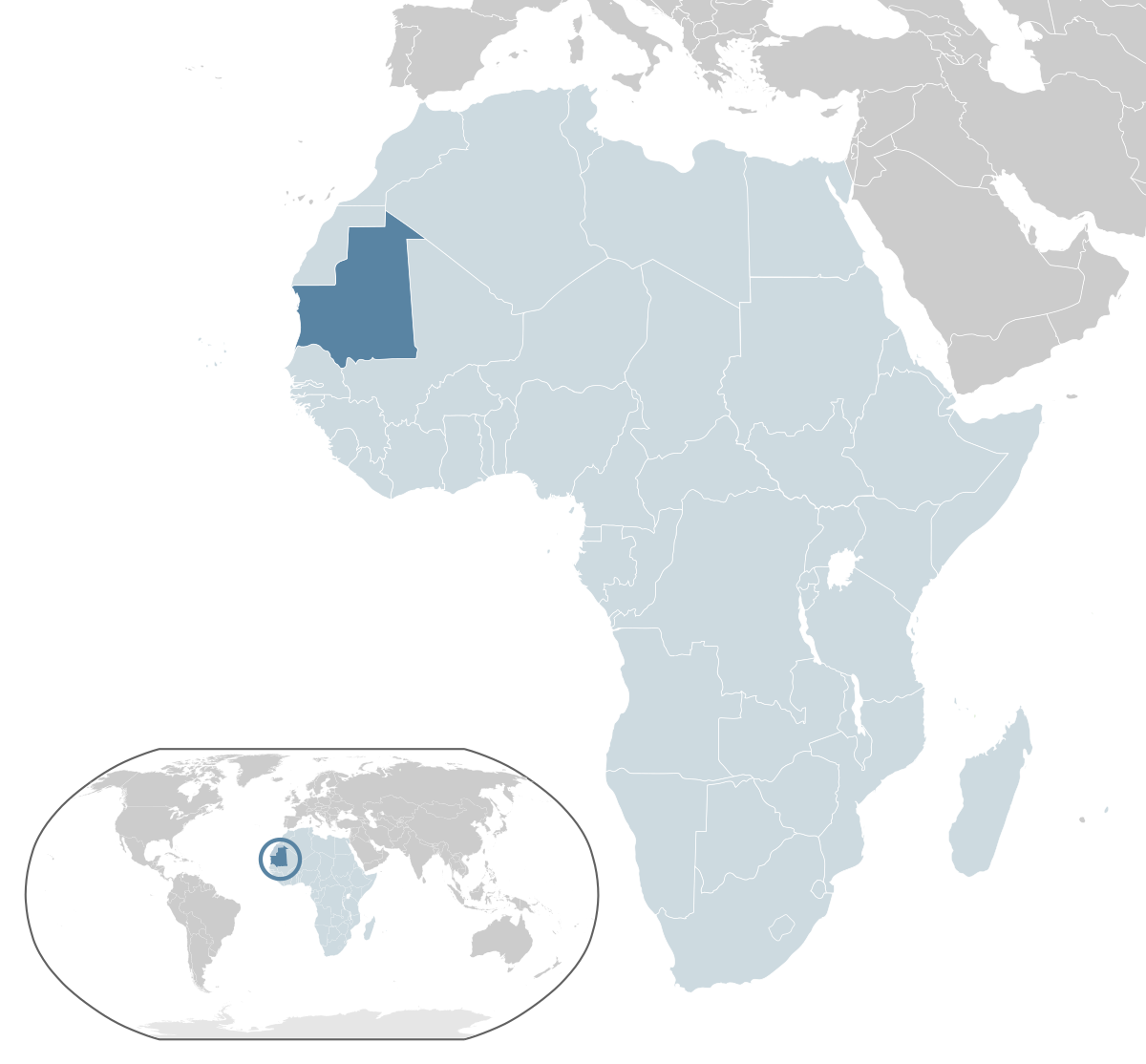
Mauritania has a need for modern infrastructure and help is on it’s way as diplomatic relations have been forged by the leadership to present projects to the modernize the country with more water, roads and waste management system that generate electricity from clean-burning plastic garbage. We hope to solve two problems at once, plus create jobs.
Mauritania from the CIA World Fact Book
Map by Alvaro1984 18 – Own work, Public Domain, Link
Independent from France in 1960, Mauritania annexed the southern third of the former Spanish Sahara (now Western Sahara) in 1976 but relinquished it after three years of raids by the Polisario guerrilla front seeking independence for the territory. Maaouya Ould Sid Ahmed TAYA seized power in a coup in 1984 and ruled Mauritania with a heavy hand for more than two decades. A series of presidential elections that he held were widely seen as flawed. A bloodless coup in August 2005 deposed President TAYA and ushered in a military council that oversaw a transition to democratic rule. Independent candidate Sidi Ould Cheikh ABDALLAHI was inaugurated in April 2007 as Mauritania’s first freely and fairly elected president. His term ended prematurely in August 2008 when a military junta led by General Mohamed Ould Abdel AZIZ deposed him and installed a military council government. AZIZ was subsequently elected president in July 2009 and sworn in the following month. AZIZ sustained injuries from an accidental shooting by his own troops in October 2012 but has continued to maintain his authority. He was reelected in 2014 to a second and final term as president (according to the present constitution). AZIZ will be replaced through elections scheduled for June 2019. The country continues to experience ethnic tensions among three major groups: Arabic-speaking descendants of slaves (Haratines), Arabic-speaking “White Moors” (Beydane), and members of Sub-Saharan ethnic groups mostly originating in the Senegal River valley (Halpulaar, Soninke, and Wolof).

Al-Qaeda in the Islamic Maghreb (AQIM) launched a series of attacks in Mauritania between 2005 and 2011, murdering American and foreign tourists and aid workers, attacking diplomatic and government facilities, and ambushing Mauritanian soldiers and gendarmes. A successful strategy against terrorism that combines dialogue with the terrorists and military actions has prevented the country from further terrorist attacks since 2011. However, AQIM and similar groups remain active in neighbouring Mali and elsewhere in the Sahel region and continue to pose a threat to Mauritanians and foreign visitors.
Demographic profile of Mauritania:
With a sustained total fertility rate of about 4 children per woman and almost 60% of the population under the age of 25, Mauritania’s population is likely to continue growing for the foreseeable future. Mauritania’s large youth cohort is vital to its development prospects, but available schooling does not adequately prepare students for the workplace. Girls continue to be underrepresented in the classroom, educational quality remains poor, and the dropout rate is high. The literacy rate is only about 50%, even though access to primary education has improved since the mid-2000s. Women’s restricted access to education and discriminatory laws maintain gender inequality – worsened by early and forced marriages and female genital cutting.

The denial of education to black Moors also helps to perpetuate slavery. Although Mauritania abolished slavery in 1981 (the last country in the world to do so) and made it a criminal offence in 2007, the millenniums-old practice persists largely because anti-slavery laws are rarely enforced and the custom is so ingrained. According to a 2018 nongovernmental organization’s report, a little more than 2% of Mauritania’s population is enslaved, which includes individuals subjected to forced labour and forced marriage, although many thousands of individuals who are legally free contend with discrimination, poor education, and a lack of identity papers and, therefore, live in de facto slavery. The UN and international press outlets have claimed that up to 20% of Mauritania’s population is enslaved, which would be the highest rate worldwide.

Drought, poverty, and unemployment have driven out migration from Mauritania since the 1970s. Early flows were directed toward other West African countries, including Senegal, Mali, Cote d’Ivoire, and Gambia. The 1989 Mauritania-Senegal conflict forced thousands of black Mauritanians to take refuge in Senegal and pushed labour migrants toward the Gulf, Libya, and Europe in the late 1980s and early 1990s. Mauritania has accepted migrants from neighbouring countries to fill labour shortages since its independence in 1960 and more recently has received refugees escaping civil wars, including tens of thousands of Tuaregs who fled Mali in 2012.

Mauritania was an important transit point for sub-Saharan migrants moving illegally to North Africa and Europe. In the mid-2000s, as border patrols increased in the Strait of Gibraltar, security increased around Spain’s North African enclaves (Ceuta and Melilla), and Moroccan border controls intensified, illegal migration flows shifted from the Western Mediterranean to Spain’s Canary Islands. In 2006, departure points moved southward along the West African coast from Morocco and Western Sahara to Mauritania’s two key ports (Nouadhibou and the capital Nouakchott), and illegal migration to the Canaries peaked at almost 32,000. The numbers fell dramatically in the following years because of joint patrolling off the West African coast by Frontex (the EU’s border protection agency), Spain, Mauritania, and Senegal; the expansion of Spain’s border surveillance system; and the 2008 European economic downturn.

Population Distribution
With most of the country being a desert, vast areas of the country, particularly in the central, northern, and eastern areas, are without sizable population clusters; half the population lives in or around the coastal capital of Nouakchott; smaller clusters are found near the southern border with Mali and Senegal.
Photo credit: valerian.guillot on Visual hunt / CC BY Photo credit: Magharebia on VisualHunt.com / CC BY Photo credit: valerian.guillot on Visual hunt / CC BY Photo credit: amelimage on Visualhunt.com / CC BY-SA

No comments yet.